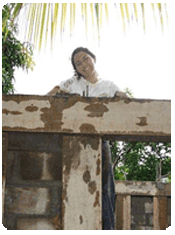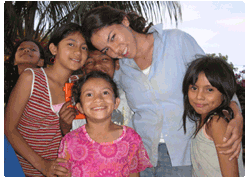Meet Ana!

Helping is a Way of Life
Ana is one busy world traveler, and Nicaragua is her country of choice. As part of her unique job, she goes there to build homes and help communities in need grow.
Describe your job. Are there any typical days for you?
Due to the nature of my job, I find myself working on various projects with different timelines. Presently, I am organizing the Spring Gala for the nonprofit I work for, Bridges to Community, but just a week and a half ago I was in Nicaragua working on building a community center and an educational project.
Describe your path to your career. Was it always your dream to do this kind of work?
Since I was a young girl, my parents always emphasized the importance of empowering those that were unable to stand or speak up for themselves. My family and I would travel yearly to Ecuador (where my parents are from) to rebuild classrooms in the [communities of the] Andes Mountains that lacked adequate shelters or materials for their students.
In college, a dear friend of mine introduced me to Bridges. My first trip to Nicaragua was a very moving experience, so moving that I spent the next two years living and working with Bridges as a Project Coordinator in Ticuantepe, Nicaragua. More than a dream, doing this type of work is a way of life for me. However, I never take for granted how fortunate I am to be able to learn and experience all the things I have from the communities in which we work.
What was it like to live with the local community, eating their traditional foods and using their facilities?
There was never a dull moment! In the beginning it was a challenge to get used to just eating what the locals did. Daily meals were rice, beans and plantains, quite different from the array of food that you can find in New York City, where I grew up.
The biggest challenge for me (and I believe most of the participants) in the beginning is showering with cold water. In most of Nicaragua, people don’t have the luxury of clean, filtered water, let alone hot water. In the community one must take bucket showers, and use latrines. I always told the groups to look at it as an opportunity to experience something new and beautiful. “When else will you have the chance to shower under the stars?!” I’d say.
We take for granted what others in 80% of the world have to fight to get. Today, in an effort to remember, I run cold water for five minutes at the end of my showers.
How did you communicate with residents of the community?
We communicated through laughter, tears and love. In terms of languages, we spoke Spanish, which is what the majority of Nicaraguans speak. On the Atlantic Coast there are indigenous peoples that speak Misquito [a native language of Central America], and a population that actually speaks Creole English. However, being on the Pacific Coast, we mainly spoke Spanish.
What is it like for women in the communities you visit?
The women in the communities that I have met are some of the strongest individuals I have ever had the privilege of knowing. The majority of them live in inadequate housing and many are forced to raise their children on under two dollars a day. With all the obstacles that face them daily—physical abuse, illnesses they can’t afford to medicate, and illiteracy—many of them find a way to overcome their daily trails, like my good friend and co-worker, Ana Julia.
Ana Julia is forty and a single mother of three, who not only fought during many years of war in Nicaragua but managed to graduate with a degree in biology and taught others how to read and write during literacy campaigns. As a single mother she built her own house on the land where a tin shack once sheltered her family. Today she continues to work for her people as one of our site coordinators.
Do the families you build the houses for have to pay for them?
 Yes, however, the money that we collect only covers half of the material cost of the house ($1,200) and then goes into a revolving fund for other projects, which the community decides how to use.
Yes, however, the money that we collect only covers half of the material cost of the house ($1,200) and then goes into a revolving fund for other projects, which the community decides how to use.
On one of your more recent trips you started a sewing class for the women of the community as a way for them to gain financial independence. How did you come up with the idea? Has it been successful?
Before I left Nicaragua it was important to me that I help create an opportunity for women in the communities that I worked in. So, I thought of a trade that wouldn’t require reading or writing and one that they would be interested in. Most importantly, it had to be something sustainable [something that would be extremely useful in their day-to-day lives].
With a sewing cooperative, the women could earn as much as they put in. For each item that the women made, 50% of the earnings would go to the artist who made it and then the other percentage would go into the cooperative’s fund, to buy more materials, machines, or for special loans. At that time there were two interns volunteering from the Maryland Institute of Art, and together we taught women the basics of art, printing, and dying techniques for fabrics. Some of the local women knew the trade of sewing well (as they had worked in sweat shops) but never owned a machine of their own. When they heard about the project that was to begin, many of them offered to teach the skill for free. With some help from friends, we bought two sewing machines and the rest is history.
It was rewarding to be back in Nicaragua this time around because the community center that we were building was going to house their cooperative. Their work was shown in an art gallery in Pittsburg, PA! I am very proud of them.
How do you decide where to go on missions and how do you involve the local community in the process?
Bridges to Community has been working on development projects in Nicaragua for the past 15 years. In those years, we have been very careful about choosing where to work. With each of our projects, our staff must depend on the input and guidance of local community leaders to ensure the community’s involvement, investment, and ownerships of the project. We never go seeking out projects. When communities are organized and there is a need, we go. Once in the community, we rely on them for everything. They provide groups visiting with shelter, food, and lots of friendships. It is our goal to empower the communities in which we work and leave with the hope that they will take the reins and move forward.
What do you do for fun?
I go to Nicaragua to shovel cement and visit my friends!

 Beth helps women start their own businesses. Meet Beth
Beth helps women start their own businesses. Meet Beth  Juliette is a teen CEO who runs a website for girls, by girls. Meet Juliette
Juliette is a teen CEO who runs a website for girls, by girls. Meet Juliette  Katrina is a floral designer and entrepreneur who runs her own business. Meet Katrina
Katrina is a floral designer and entrepreneur who runs her own business. Meet Katrina